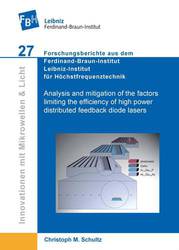| Departments | |
|---|---|
| Book Series (96) |
1379
|
| Nachhaltigkeit |
3
|
| Gesundheitswesen |
1
|
| Humanities |
2367
|
| Natural Sciences |
5407
|
| Mathematics | 229 |
| Informatics | 319 |
| Physics | 980 |
| Chemistry | 1364 |
| Geosciences | 131 |
| Human medicine | 243 |
| Stomatology | 10 |
| Veterinary medicine | 108 |
| Pharmacy | 147 |
| Biology | 835 |
| Biochemistry, molecular biology, gene technology | 121 |
| Biophysics | 25 |
| Domestic and nutritional science | 45 |
| Agricultural science | 1004 |
| Forest science | 201 |
| Horticultural science | 20 |
| Environmental research, ecology and landscape conservation | 148 |
| Engineering |
1793
|
| Common |
98
|
|
Leitlinien Unfallchirurgie
5. Auflage bestellen |
|
Advanced Search
Analysis and mitigation of the factors limiting the efficiency of high power distributed feedback diode lasers (Volume 27) (English shop)
Christoph Matthias Schultz (Author)Preview
Extract, PDF (110 KB)
Table of Contents, PDF (52 KB)
High-power, high-efficiency, wavelength-stabilized broad area (BA) diode lasers are promising devices for industrial applications. They can be used, for example, for pumping narrow absorption bands in gain media of solid-state and fiber lasers as well as for power scaling by means of dense spectral beam combining.
This thesis focuses on the analysis and mitigation of the factors limiting the efficiency of high-power distributed feedback (DFB) diode lasers. In particular, it will be shown how a power conversion efficiency in the 60 %-range can be achieved from 10 W-class 100 μm stripe DFB-BA lasers – values close to those of state-of-the-art Fabry-Pérot (FP) BA lasers. For the first time world-wide, newly developed DFB-BA lasers achieve 12 W continuous mode optical output power with 62 % peak power conversion efficiency and 58 % at 10 W, respectively. Wavelength stabilization is demonstrated from threshold to 15 A with a spectral width below 0.8 nm containing 95 % of the emitted power. The factors limiting the efficiency of DFB-BA lasers compared to state-of-the-art 10 W-class FP-BA lasers have been identified and as a result largely eliminated.
| ISBN-13 (Hard Copy) | 9783954045211 |
| ISBN-13 (eBook) | 9783736945210 |
| Final Book Format | A5 |
| Language | German |
| Page Number | 388 |
| Lamination of Cover | matt |
| Edition | 1 Aufl. |
| Book Series | Innovationen mit Mikrowellen und Licht. Forschungsberichte aus dem Ferdinand-Braun-Institut, Leibniz-Institut für Höchstfrequenztechnik |
| Volume | 27 |
| Publication Place | Göttingen |
| Place of Dissertation | Berlin |
| Publication Date | 2013-10-08 |
| General Categorization | Dissertation |
| Departments |
Physics
|
| Keywords | Physik der kondensierten Materie, distributed feedback, power conversion efficiency, high power diode lasers |








